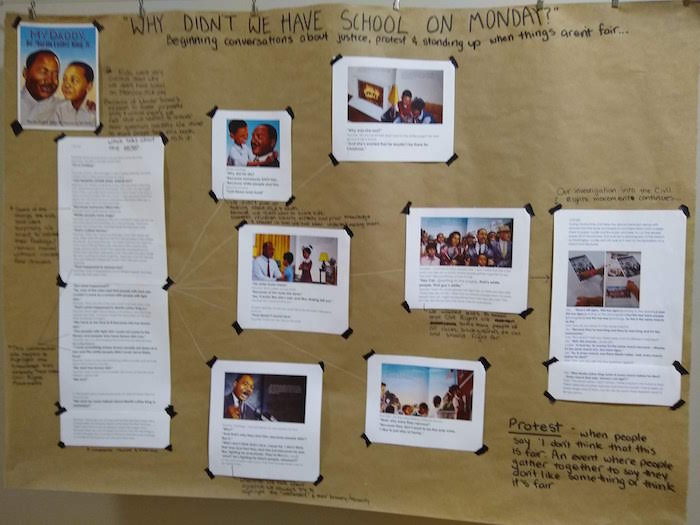
There is no “too young” to start talking about race and racism with children. But with something as big and heavy as racism, where do you even begin?
Our approach to anti-racist work with young children at CMA is to begin with ourselves—with some honest self reflection and ongoing self-education. The more your own anti-racist work is grounded in self-reflection and knowing/understanding the forces behind systemic racism, the more comfortable and confident you will be in approaching every conversation with the children in your care, whatever your context. Before going further, I do want to offer a few very big caveats: because self-reflection is by definition personal, because my own life has been lived as a White person, and because White privilege allowed me to live most of my life without thinking about racism, a lot of the resources I will be sharing will be especially relevant to White parents and educators just getting started. I feel okay about this for two reasons—one, I can only ever be true to my own experience and two, systems of oppression are for the oppressor, not the oppressed, to dismantle. In other words, racism is a White people problem.
Did that last sentence make you feel a bit uncomfortable? Good! THAT is the place to start—by reckoning with your own privilege and unearthing how White supremacist thinking shows up in you. White supremacy isn’t something “those bad people over there do,” It’s in the air and water and laws and systems that make our daily life. While there are countless resources that could work for you, here are the three that helped me make sense of my own position and complicity within the systems of racism:
- On Being’s interview with Eula Biss (author of the essay White Debt)
- Me and White Supremacy by Layla Saad
- So You Want to Talk About Race by Ijeoma Oluo (also available in downloadable audiobook through the Columbus Metropolitan Library)
While you do not need a PhD in history to have honest and thoughtful conversations about race and racism with four year olds. It is, however, helpful to have some context. Knowing a bit more about what came before now can also help you find quality picture books (more on that in a later post) and find exciting heroes like Ron McNair or Claudette Colvin to share with children. Some of my favorite history resources include:
- Uncivil podcast (looks at the untold stories of the American Civil War)
- Freedom’s Daughters: Unsung Heroines of the Civil Rights Movement by Lynne Olsen.
In the midst of all this self education, which can at times feel so heavy, take some time to learn about and savor the beauty, joy and resilience found in non-white cultures. Seek out and try new recipes from different communities, read poetry and fiction by/about Black/Indigenous/People of Color. Doing so will not only feed your own heart and allow you to stay in this for the long game, it will also help you to see BIPOC as fully realized and complex humans (Fellow sci-fi and fantasy nerds- anything by N.K. Jemmison and Octavia Butler is tops).
Finally, I want to end this post with a warning and a word of encouragement. If you are White person, and especially if you are new to working/thinking/speaking in this way, you will likely feel up to your ears in guilt, shame, overwhelmed and exhausted. This is normal— these are sad things to think and talk about, and many of us have lived lives with the privilege of not-seeing. If you are there, remember: one function of White Supremacy is to convince you that you are fragile, that you can’t do this, but you can! You can do hard things! Not only that, but at a certain point, anti-racist work will become another lens through which you live. The work will still be hard and often sad, but there is also joy to be found in meeting your edge, seeing that you are tough and, most importantly, doing so in service of the children who will inherit the world after us.
Over the next few weeks, we will continue to share a series of blog posts unpacking each of our main strategies behind anti-racist teaching with young children. In each we will share resources, including documentation from the classroom, picture books, artwork from the collection and links to resources that have been invaluable in our own efforts. These strategies include
- Self-reflection and self-education
- Explicitly naming race and talking about difference in a joyful way
- Talking in a developmentally appropriate way about injustices- both from the past and present.
- Being intentional in choosing picture books that both feature Black, Indiginous, People of Color characters AND that are by BIPOC authors/artists.
- Supporting and fostering imagination, as a powerful tool for radical social change.
– Caitlyn Lynch is CMA Lead Teaching Artist & Coordinator for Young Child Programming including Wonder School, an arts-rich laboratory preschool launched in 2018 in collaboration with Columbus State Community College, Columbus Museum of Art, and The Childhood League Center. Wonder School fosters purposeful play, critical inquiry, and a collaborative community approach to education—for children, for their educators, for a more creative and compassionate society.
